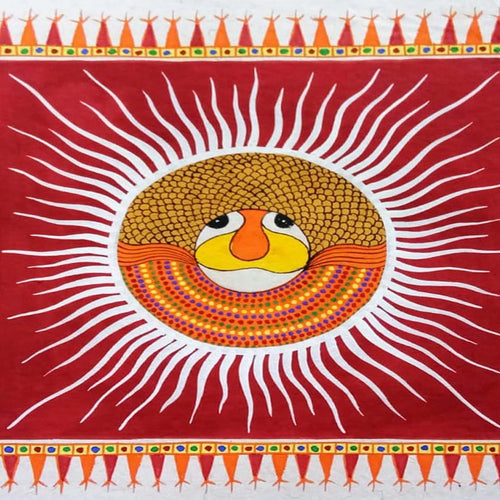What is Pithora Painting?
Pithora painting is a vibrant and ritualistic art form practiced by the Rathwa, Bhilala, and Bhil tribes in the regions of Gujarat and Madhya Pradesh. Unlike decorative wall art, Pithora art holds deep spiritual significance. Created as a part of rituals to invoke blessings, these paintings serve as sacred offerings to the deities.
The artwork is a dynamic combination of tribal symbolism, folk stories, and natural elements, and reflects the interconnectedness of life, nature, and the divine. Rich with symbolic motifs like horses (representing Pithora Baba), celestial bodies, and village life, each Pithora art painting becomes a narrative tapestry of tribal identity.
Pithora Art History and Tradition
Roots in Ritual – A Spiritual Journey Through Time
The history of Pithora painting dates back centuries and is closely tied to the oral traditions and religious practices of the tribal communities. According to legend, these paintings were first made to honor Pithora Baba, a deity said to protect and guide the tribe.
The Ritual Process
-
Location: Typically painted on the inner walls of the Pithora Ghar (sacred room).
-
Ceremony: Led by the tribal priest or Badwa, with assistance from the artist known as a Lakhara.
-
Intentions: Created to fulfill vows, invite prosperity, or heal ailments.
This process makes every Pithora painting artist not just a painter but a cultural storyteller and spiritual conduit.
Materials and Techniques in Pithora Art
Natural Colors, Sacred Surfaces
|
Element
|
Description
|
|
Surface
|
Mud-lime plastered walls, prepared for sacred storytelling
|
|
Pigments
|
Natural dyes like turmeric, vermilion, rice flour, indigo
|
|
Painting Method
|
Freehand painting guided by priest's chants; divided into 3 cosmic zones
|
|
Modern Tools
|
Contemporary artists also use synthetic pigments for durability
|
Tripartite Composition
-
Top: Heavens and cosmic elements (sun, moon, stars)
-
Middle: Human and animal life
-
Bottom: Ancestral spirits and underworld beings
This structure reinforces the Rathwa painting tradition of depicting the tribal worldview.
The Visual Language of Pithora Art
Symbolism and Motifs in Pithora Art Painting
Pithora art images are recognizable by their:
Common Themes in Bhil Pithora Art
-
Horses – Vehicles of deities, especially Pithora Baba
-
Village scenes – Daily life, festivals, harvests
-
Nature – Trees, animals, birds, sky
-
Cosmos – Sun, moon, stars as recurring cosmic entities
Artists like Bhuri Bai, a celebrated exponent of Bhuri Bai Pithora painting, have gained national acclaim for evolving these traditions while maintaining authenticity.
Pithora Painting in the Modern World
Pithora painting images now find space in:
Despite modern exposure, the core of Pithora tradition remains rooted in community storytelling, making each piece a living embodiment of cultural heritage.
Collection Highlights – Pithora Art Images & Works
Explore our curated gallery of:
-
Traditional Pithora art paintings
-
Exclusive Bhil Pithora art
-
Works by notable artists including Bhuri Bai
-
Authentic wall panels and canvas adaptations
Every piece you see here celebrates the Pithora history, rituals, and craftsmanship passed down generations.
FAQs – Learn More About Pithora Paintings
Q1: Are Pithora paintings purely decorative?
A: No. These artworks are deeply spiritual and ritualistic in nature. Each piece is created with intent—whether to honor a vow, seek blessings, or invite prosperity.
Q2: Who are the creators of Pithora paintings?
A: Mostly male tribal artists known as Lakhara, under the guidance of a priest Badwa. Renowned artists like Bhuri Bai have also brought female representation into the fold.
Q3: What is the significance of horses in Pithora paintings?
A: Horses symbolize deities, particularly Pithora Baba, and act as sacred vehicles in the narrative.
Q4: Can I buy original Pithora paintings?
A: Yes! MeMeraki offers curated, authentic Pithora paintings from skilled tribal artists. Each work is ethically sourced and supports the community.
Q5: How can I support the Pithora tradition?
A: Purchase original artworks, share the Pithora art history, participate in artist workshops, and spread awareness about this invaluable cultural treasure.

